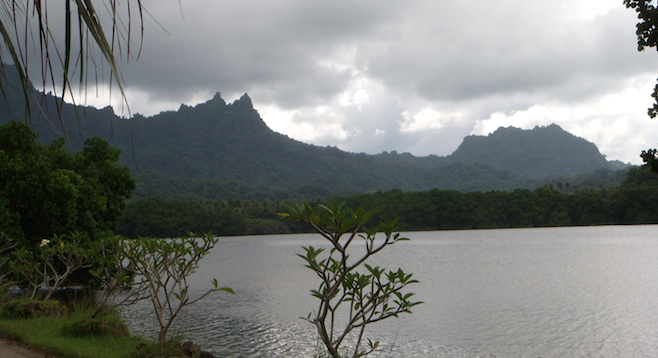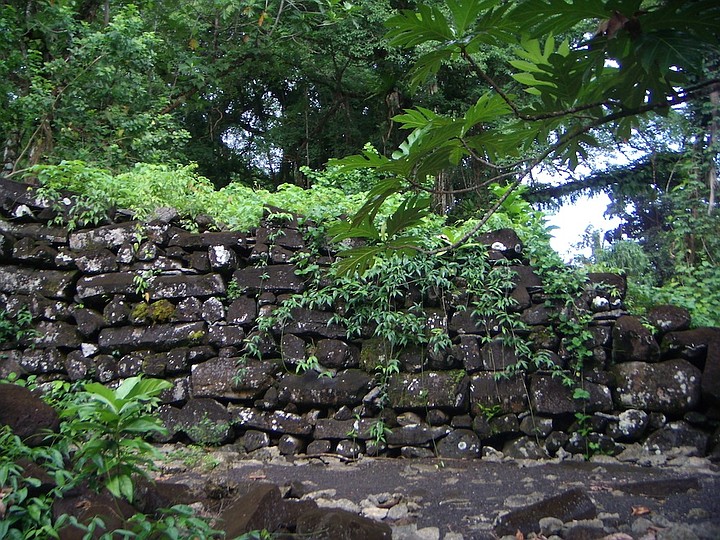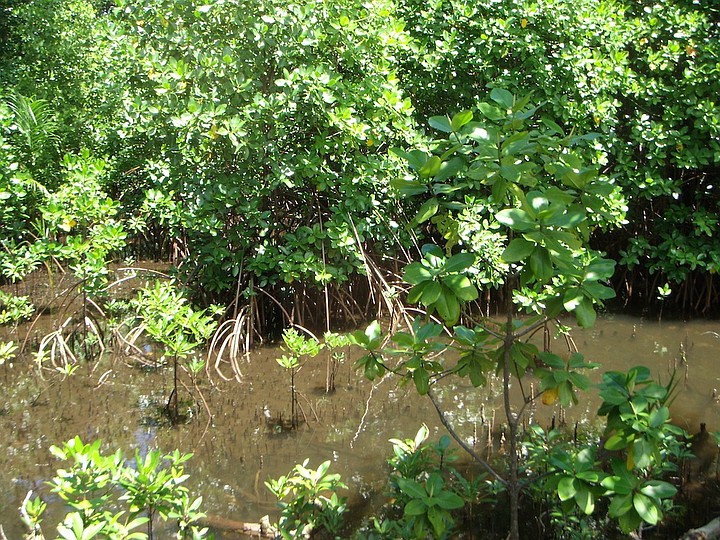 Facebook
Facebook
 X
X
 Instagram
Instagram
 TikTok
TikTok
 Youtube
Youtube

“Whenever you come to a fork in the channel, go left,” the owner of my hotel said as he prepared a kayak for me to paddle into the Mutunnenea Channel in northeastern Kosrae, Micronesia. “Eventually you’ll come to a tight place where you’ll have to turn back. Try not to get stuck and please watch the time. After dark you will get hopelessly lost,” he warned as he launched me onto the sludgy swamp.
Kosrae is the smallest and easternmost state in the Federated States of Micronesia. It lies more than 2,000 miles southwest of Hawaii and is home to about 7,000 friendly, religious, self-sufficient people. Mangrove forests surround mountainous Kosrae Island. The Mutunnenea Channel carves paths through a couple of miles of those forests near the basalt ruins of the ancient royal capital, Lelu.

Kosrae legend holds that a giant snake carved the meandering channel while searching for his daughter, who had been abducted by the King of Lelu. Inexplicably, the daughter was human – or at least looked human enough to attract the king’s attention. When the snake reached Lelu, the king trapped it in a palace building. Then he set a fire that killed the snake and also, predictably, the daughter who jumped into the flames in despair.
The first thing I noticed about the channel is that snorkeling is not an option. The water is the color and consistency of agitated Turkish coffee. Only at its shallowest edges is anything visible below the water surface. But my attention quickly switched from swamp water to luxuriant forest foliage when I emerged from the sheltered launch area.
Near the ocean, where I entered, the channel is as wide as a river. The outgoing tide offered some resistance to my upstream efforts, but paddling was easy enough and the view was splendid. In the tropical sun, the foliage of the main channel shines luminous gold-green like a parrot racing above a rainforest canopy. But when the sun descends behind the profile of Kosrae’s Sleeping Lady Mountain or is obscured by the dark clouds that often clutter the late afternoon sky, the color subdues to the gray-blue of a heron lurking in shade.
After fifteen minutes' paddling, I reached my first directional decision. Two mangrove islands divided the channel into three courses – wide to the left, narrow in the middle, and “You must be joking!” to the right.
Ignoring local advice, I chose the right-hand, reef-side course and was soon rewarded with the chance to practice kayak reversal at an impassable fallen tree. Brown bubbles of muddy foam previously churned up by my paddle provided a useful navigational aid back to open water. I chose the recommended left-hand channel when I re-emerged.
As I paddled on, the Mutunnenea continued offer me new “Y” intersection choices. Chastened by my first misstep, I took all turns to the left into the denser forest, away from the reef, as the waterway dramatically narrowed and darkened with each turn.
The tightest passages, where the forest tries to crowd out its own watery life, mysteriously attract kayakers. They draw you in, even though you know you may be grounded in the brown ooze or wedged into a clutch of roots. The more narrow and twisting and shallow the water path, the greater attraction to enter, and the greater the reward. Forest plants up here differ from those in the open spaces of the ocean end of the channel.
Back in the wide sunny sections, where the water is saltier, plant foliage descends to the waterline. But in the narrow interior freshwater-influenced passages, the lower trunks, branches and aerial roots of the trees, standing permanently in shadow, bear few leaves. Instead, they are adorned with thick furry mosses as rich and verdant as an English summer pasture and with long streamers of fern fronds cascading like a pyrotechnic display.
Kosraens have given names to their mangrove plants: Sakrasric, Flo Foi, Shrael, Fals, Melukluk, Tui. They find them useful for firewood, carving, roof thatching, furniture making and traditional medicines – as well as for trapping kayaks.

Science primers explain that the trees and other plants of mangrove forests thrive in intertidal sheltered tropical areas. With their salt-filtering aerial roots and salt-excreting leaves, these plants survive where other species cannot.
The oxygen-breathing, salt-extracting roots are obvious. They come in two basic types. Prop roots of the Sakrasric (left) look like buttresses propping up the plant’s main trunk. Pneumataphores of the Flo Foi and Shrael spike up sharply from the swamp floor like aquatic stalagmites to snorkel air during low tide. Besides those species, Fals is a trunkless palm, Melukluk is a broad-leafed fern growing high in the branches of host trees, and the Tui's dense strands congest the low shoreline with ribbony networks of tight-bunched overlapping roots.
These forests buffer the mainland against storm and wave damage, and they absorb and recycle sediment runoff. (This latter function accounts for the Turkish-coffee consistency of the water.)
What the science books don't mention is the inner forests’ mystique and the spirits they possibly harbor. A botanically challenged tourist such as myself, paddling into the upper regions of the Mutunnenea, may not be able to identify the diverse species he encounters. But if he is alert, he may imagine creatures petrified in the dense forest; and he may wonder about the snake story.
At first he might see a majestic moose head with furry green antlers, or a dragon’s neck arching toward him with its gaping mouth, or a wooden lemur hanging upside-down, reaching into the water for fruit. But later, in the dappled shadows, after he passes under a branch so low that he must lie back flat in his kayak to clear, he will notice the eyes. They aren’t really eyes, are they? They are probably something like knot holes, but they appear to grant sight to forest shapes of a watching dog, serpent, boar, ram, rhinoceros.
If the eyes don’t deter him, he reaches a curtain of aerial roots as dense as the beaded entrance to an Oriental parlor. The curtain appears impenetrable, but with difficulty he can push the thin rigid roots aside as they grab for his paddle.
Beyond this curtain, he quietly floats beneath rows of long thick pods, each suspended above his head by a single vine. In this jungle setting, he might recall the bodies hanging above the riverine entrance to Colonel Kurtz’s Cambodian lair in Apocalypse Now.
Here the brush scrapes his face and his boat; the light dims; he struggles to paddle through root spikes emerging from the receding swamp. Here the forest not only sees; it speaks. Mouths hollowed through twisted un-green trunks silently howl, “Turn back, Intruder. This place is forbidden.”
Suddenly a sleek white “sik” bird, with its long twin tail, bursts out of the gloom and jets low overhead like a vapor trail, shrieking “no no no no.” And that was enough weirdness for me. I retreated as quickly as my arms and the swamp’s obstructions would allow, and it was not too soon.
I had thought the impending darkness was caused by the shadowy forest cover, but when I reached a wider passage and could see the sky again, I realized there was another, more serious reason. The sun was setting. Then I remembered something my host had warned about an ominous connection between darkness and hopelessness.
My leisurely sightseeing float was now a K-1 sprint final. With the tide at my back, I barely reached my hotel before anyone needed to interrupt cocktail hour to search for me.
I pulled my kayak onto the landing and stumbled, muddy and wet, into the hotel bar. I wanted to announce to the gathered drinkers that a giant snake had surely carved Mutunnenea and that malevolent spirits haunted its upper reaches. But a waitress distracted me with the offer of cold beer. And the moment was lost.


“Whenever you come to a fork in the channel, go left,” the owner of my hotel said as he prepared a kayak for me to paddle into the Mutunnenea Channel in northeastern Kosrae, Micronesia. “Eventually you’ll come to a tight place where you’ll have to turn back. Try not to get stuck and please watch the time. After dark you will get hopelessly lost,” he warned as he launched me onto the sludgy swamp.
Kosrae is the smallest and easternmost state in the Federated States of Micronesia. It lies more than 2,000 miles southwest of Hawaii and is home to about 7,000 friendly, religious, self-sufficient people. Mangrove forests surround mountainous Kosrae Island. The Mutunnenea Channel carves paths through a couple of miles of those forests near the basalt ruins of the ancient royal capital, Lelu.

Kosrae legend holds that a giant snake carved the meandering channel while searching for his daughter, who had been abducted by the King of Lelu. Inexplicably, the daughter was human – or at least looked human enough to attract the king’s attention. When the snake reached Lelu, the king trapped it in a palace building. Then he set a fire that killed the snake and also, predictably, the daughter who jumped into the flames in despair.
The first thing I noticed about the channel is that snorkeling is not an option. The water is the color and consistency of agitated Turkish coffee. Only at its shallowest edges is anything visible below the water surface. But my attention quickly switched from swamp water to luxuriant forest foliage when I emerged from the sheltered launch area.
Near the ocean, where I entered, the channel is as wide as a river. The outgoing tide offered some resistance to my upstream efforts, but paddling was easy enough and the view was splendid. In the tropical sun, the foliage of the main channel shines luminous gold-green like a parrot racing above a rainforest canopy. But when the sun descends behind the profile of Kosrae’s Sleeping Lady Mountain or is obscured by the dark clouds that often clutter the late afternoon sky, the color subdues to the gray-blue of a heron lurking in shade.
After fifteen minutes' paddling, I reached my first directional decision. Two mangrove islands divided the channel into three courses – wide to the left, narrow in the middle, and “You must be joking!” to the right.
Ignoring local advice, I chose the right-hand, reef-side course and was soon rewarded with the chance to practice kayak reversal at an impassable fallen tree. Brown bubbles of muddy foam previously churned up by my paddle provided a useful navigational aid back to open water. I chose the recommended left-hand channel when I re-emerged.
As I paddled on, the Mutunnenea continued offer me new “Y” intersection choices. Chastened by my first misstep, I took all turns to the left into the denser forest, away from the reef, as the waterway dramatically narrowed and darkened with each turn.
The tightest passages, where the forest tries to crowd out its own watery life, mysteriously attract kayakers. They draw you in, even though you know you may be grounded in the brown ooze or wedged into a clutch of roots. The more narrow and twisting and shallow the water path, the greater attraction to enter, and the greater the reward. Forest plants up here differ from those in the open spaces of the ocean end of the channel.
Back in the wide sunny sections, where the water is saltier, plant foliage descends to the waterline. But in the narrow interior freshwater-influenced passages, the lower trunks, branches and aerial roots of the trees, standing permanently in shadow, bear few leaves. Instead, they are adorned with thick furry mosses as rich and verdant as an English summer pasture and with long streamers of fern fronds cascading like a pyrotechnic display.
Kosraens have given names to their mangrove plants: Sakrasric, Flo Foi, Shrael, Fals, Melukluk, Tui. They find them useful for firewood, carving, roof thatching, furniture making and traditional medicines – as well as for trapping kayaks.

Science primers explain that the trees and other plants of mangrove forests thrive in intertidal sheltered tropical areas. With their salt-filtering aerial roots and salt-excreting leaves, these plants survive where other species cannot.
The oxygen-breathing, salt-extracting roots are obvious. They come in two basic types. Prop roots of the Sakrasric (left) look like buttresses propping up the plant’s main trunk. Pneumataphores of the Flo Foi and Shrael spike up sharply from the swamp floor like aquatic stalagmites to snorkel air during low tide. Besides those species, Fals is a trunkless palm, Melukluk is a broad-leafed fern growing high in the branches of host trees, and the Tui's dense strands congest the low shoreline with ribbony networks of tight-bunched overlapping roots.
These forests buffer the mainland against storm and wave damage, and they absorb and recycle sediment runoff. (This latter function accounts for the Turkish-coffee consistency of the water.)
What the science books don't mention is the inner forests’ mystique and the spirits they possibly harbor. A botanically challenged tourist such as myself, paddling into the upper regions of the Mutunnenea, may not be able to identify the diverse species he encounters. But if he is alert, he may imagine creatures petrified in the dense forest; and he may wonder about the snake story.
At first he might see a majestic moose head with furry green antlers, or a dragon’s neck arching toward him with its gaping mouth, or a wooden lemur hanging upside-down, reaching into the water for fruit. But later, in the dappled shadows, after he passes under a branch so low that he must lie back flat in his kayak to clear, he will notice the eyes. They aren’t really eyes, are they? They are probably something like knot holes, but they appear to grant sight to forest shapes of a watching dog, serpent, boar, ram, rhinoceros.
If the eyes don’t deter him, he reaches a curtain of aerial roots as dense as the beaded entrance to an Oriental parlor. The curtain appears impenetrable, but with difficulty he can push the thin rigid roots aside as they grab for his paddle.
Beyond this curtain, he quietly floats beneath rows of long thick pods, each suspended above his head by a single vine. In this jungle setting, he might recall the bodies hanging above the riverine entrance to Colonel Kurtz’s Cambodian lair in Apocalypse Now.
Here the brush scrapes his face and his boat; the light dims; he struggles to paddle through root spikes emerging from the receding swamp. Here the forest not only sees; it speaks. Mouths hollowed through twisted un-green trunks silently howl, “Turn back, Intruder. This place is forbidden.”
Suddenly a sleek white “sik” bird, with its long twin tail, bursts out of the gloom and jets low overhead like a vapor trail, shrieking “no no no no.” And that was enough weirdness for me. I retreated as quickly as my arms and the swamp’s obstructions would allow, and it was not too soon.
I had thought the impending darkness was caused by the shadowy forest cover, but when I reached a wider passage and could see the sky again, I realized there was another, more serious reason. The sun was setting. Then I remembered something my host had warned about an ominous connection between darkness and hopelessness.
My leisurely sightseeing float was now a K-1 sprint final. With the tide at my back, I barely reached my hotel before anyone needed to interrupt cocktail hour to search for me.
I pulled my kayak onto the landing and stumbled, muddy and wet, into the hotel bar. I wanted to announce to the gathered drinkers that a giant snake had surely carved Mutunnenea and that malevolent spirits haunted its upper reaches. But a waitress distracted me with the offer of cold beer. And the moment was lost.
Comments